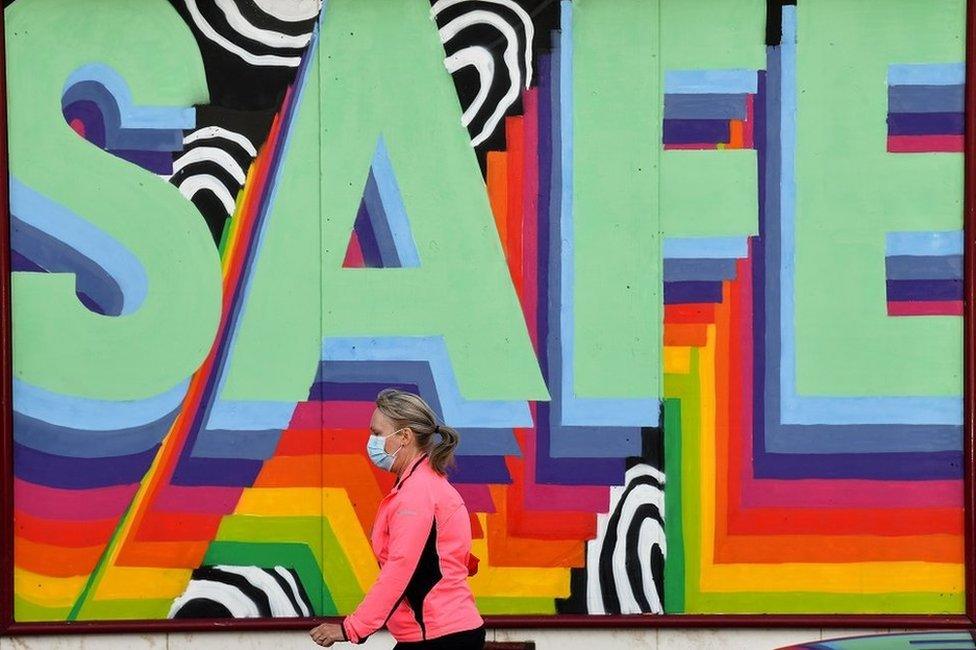Coronavirus in Scotland: What is the magic (R) number?
- Published

Before lockdown in Scotland one person with coronavirus had the potential to infect six other people. We are now 12 weeks on from the "stay at home" restrictions, so is that infection level still the same?
The latest data indicated that on 5 June the so-called R-number was between 0.6 and 0.8 - the week previous to that it sat between 0.7 and 0.9.
The Scottish government promised to give a weekly update on the re-infection rates and ahead of doing that, scientists and statisticians briefed journalists in mid-May.
They began their "technical" explainer by talking about a computer. It's based at Edinburgh University and took nearly 60 hours to make an important calculation.
This wasn't a throwback to the age of slow dial-up internet, nor was it an attempt to compute the answer to life, universe, and everything.
Rather it took an entire weekend for this top of the line computer to run varying models to calculate something called the R number.
Put simply, the R (or reproduction) value is a way of rating a disease's ability to spread.
It's the number of people that one infected person, who for example has coronavirus, will pass on, on average.
What is a bad number?
For example, measles has one of the highest R numbers of 15 in populations without immunity.
But what does that really mean? Let me illustrate.
At a rate of 1.1 (or R 1.1), 1,000 people could potentially cause the infections of almost 25,000 people over 60 days.
But at R 0.5, the number of infections would be under 2,500.
So the take-home point? Anything over R 1 = very bad.
Covid-19 has been broadly estimated to have a reproduction number of three (before lockdown), but this value varies region to region.
And so the unenviable task that this Edinburgh-based computer has is to calculate the R number for the coronavirus outbreak in Scotland.

The more businesses open up, there is a greater risk of the R number going up
At the government briefing, journalists learned that estimates for the R number in Scotland ranged as high as 6 before social distancing measures were put in place.
This R value since then has hovered around the 0.7 - 1 mark.
But why the range, and why does it take a computer so long to generate a single number?
Well, reporters were told that a range of data has to be used to calculate the R value.
This data includes;
the number of confirmed coronavirus cases across Scotland
ICU admissions
the average length of a person's hospital stay
the number of deaths
and even deprivation data.
On that latter note, the National Records of Scotland revealed how the death rate from Covid-19 is significantly higher in the top quintile of people living in deprived areas, external
Even then, we learned there's still a great deal of uncertainty over the accuracy of this calculation as experts try their best to analyse what is a rapidly moving and evolving target.
So, to improve this accuracy, multiple computer models from institutions such as Imperial College London and The London School of Hygiene and Tropical Medicine are run to better pinpoint a consistent rate.

SCHOOLS: When will children be returning?
EXERCISE: What are the guidelines on getting out?
THE R NUMBER: What it means and why it matters
AIR TRAVELLERS: The new quarantine rules
LOOK-UP TOOL: How many cases in your area?

For example in the early weeks of using this modelling, Imperial generated an R number of 0.7 to 1, whereas The London School of Hygiene and Tropical Medicine produced a value greater than 1.
Given the complexity of the task and the lack of real-time data, it's then no surprise to learn that separate R numbers for care homes, hospitals and other communities are not easy to come by.
And at her briefing on Wednesday of this week, Nicola Sturgeon said she did not had a reliable breakdown for different regions of Scotland - so the 0.6-0.8 range issued on Thursday is for the whole of the country.
The technical briefing mid-May also revealed that age and underlying health conditions are the main reasons for why the R rate is higher in Scotland than say, London which has previously recorded a rate of 0.4.
An essential point is that Scotland has a larger aging population than other regions.
At the end of the day though, journalists were told there was no magic R number that will trigger the end of a Scottish lockdown. It's not exact and it's always presented as a range - but it's there to help politicians make decisions about what restrictions should be lifted and when they should go.


Use the form below to send us your questions and we could be in touch.
In some cases your question will be published, displaying your name, age and location as you provide it, unless you state otherwise. Your contact details will never be published. Please ensure you have read the terms and conditions.
If you are reading this page on the BBC News app, you will need to visit the mobile version of the BBC website to submit your question on this topic.